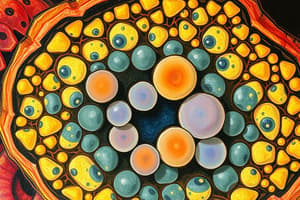Podcast
Questions and Answers
Which of the following are membranous organelles? (Select all that apply)
Which of the following are membranous organelles? (Select all that apply)
- Mitochondria (correct)
- Ribosomes
- Cytoskeleton
- Nucleus (correct)
What does the nucleus contain?
What does the nucleus contain?
Chromosomal DNA (chromatin), nucleoplasm, and nucleoli.
What is the function of mitochondria?
What is the function of mitochondria?
Generating ATP as the cell's energy supply.
What is contained in the mitochondrial matrix?
What is contained in the mitochondrial matrix?
What is the endoplasmic reticulum (ER)?
What is the endoplasmic reticulum (ER)?
Rough ER has attached ribosomes.
Rough ER has attached ribosomes.
Smooth ER functions in protein synthesis.
Smooth ER functions in protein synthesis.
What does the Golgi apparatus do?
What does the Golgi apparatus do?
What do lysosomes contain?
What do lysosomes contain?
What are peroxisomes responsible for?
What are peroxisomes responsible for?
What do ribosomes consist of?
What do ribosomes consist of?
What is the function of the cytoskeleton?
What is the function of the cytoskeleton?
What are microtubules composed of?
What are microtubules composed of?
What are centrioles used for during cell division?
What are centrioles used for during cell division?
What is the primary function of cilia?
What is the primary function of cilia?
What do microvilli do?
What do microvilli do?
Flashcards
Mitochondria function
Mitochondria function
Produce most of a cell's energy (ATP).
Nucleus function
Nucleus function
Houses DNA and controls cell activities.
ER function
ER function
Synthesis, storage, transport, and detoxification.
Golgi Apparatus function
Golgi Apparatus function
Signup and view all the flashcards
Lysosome function
Lysosome function
Signup and view all the flashcards
Peroxisome function
Peroxisome function
Signup and view all the flashcards
Cytoskeleton function
Cytoskeleton function
Signup and view all the flashcards
Ribosomes function
Ribosomes function
Signup and view all the flashcards
Centrioles function
Centrioles function
Signup and view all the flashcards
Cilia function
Cilia function
Signup and view all the flashcards
Flagella function
Flagella function
Signup and view all the flashcards
Microvilli function
Microvilli function
Signup and view all the flashcards
Mitochondrial Matrix
Mitochondrial Matrix
Signup and view all the flashcards
Rough ER function
Rough ER function
Signup and view all the flashcards
Smooth ER function
Smooth ER function
Signup and view all the flashcards
Study Notes
Membranous Organelles
- Mitochondria: Known as "cellular power plants," they produce about 95% of a cell's ATP, essential for energy.
- Nucleus: Houses chromosomal DNA (chromatin) and nucleolus; crucial for genetic information transmission.
- Endoplasmic Reticulum (ER): Comprised of tubules and vesicles, it plays a role in synthesis, storage, transport, and detoxification.
- Golgi Apparatus: Made of flattened membrane-bound stacks (cisternae), it packages materials for lysosomes and secretory vesicles.
- Lysosomes: Membrane-walled sacs filled with digestive enzymes that digest unwanted substances, including organelles and pathogens.
- Peroxisomes: Small sacs containing oxidases and catalases that detoxify harmful peroxides.
Non-Membranous Organelles
- Cytoskeleton: An internal protein network that provides support, shape, and intracellular movement within the cell.
- Ribosomes: Complexes of RNA and proteins that act as sites for protein synthesis; can be free in the cytosol or fixed to the ER.
- Centrioles: Barrel-shaped structures involved in cell division and the formation of cilia and flagella.
- Cilia: Hair-like projections that facilitate fluid movement across cell surfaces through rhythmic beating.
- Flagella: Whip-like structures that propel cells through fluid environments.
- Microvilli: Tiny projections that increase cell surface area, aiding in absorption and secretion.
Specialized Features of Organelles
- Mitochondrial Matrix: The inner space critical for ATP production, containing ATP synthase.
- Rough ER: Ribosome-studded, responsible for synthesizing and packaging proteins for secretion.
- Smooth ER: Lacks ribosomes; involved in lipid synthesis, metabolism, and detoxification processes.
Fiber Types in Cytoskeleton
- Microtubules: Protein tubulin polymers providing cell shape, organelle movement, and aiding in cell division.
- Microfilaments: Composed of actin, contributing to cellular structure and movement.
- Intermediate Filaments: Provide mechanical strength and support for organelles, aiding in material transport.
- Thick Filaments: Primarily made of myosin; involved in muscle contraction and cell movement.
Functional Aspects of Organelles
- Transport vesicles: Move materials between the RER and Golgi apparatus.
- Digestive function of lysosomes: Break down various cellular components and pathogens.
- Cilia and flagella movement: Essential in various cellular processes, including locomotion and nutrient movement across surfaces.
Studying That Suits You
Use AI to generate personalized quizzes and flashcards to suit your learning preferences.




